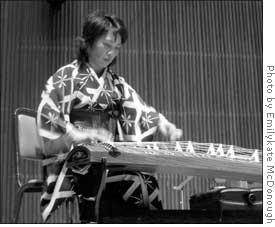
| << Front page | Arts | April 8, 2005 |
Japanese traditional music opens ears and minds in classical recital
 |
||
| Chieko Iwazaki: One of Japanís virtuoso koto players performing in a Japanese classical music recital Tuesday in Kulas Recital Hall. | ||
Snaps, twangs, bobbing heads, escaping air, bending pitches and hiccupping melodies are techniques practically forbidden in the Western Common Practice period. It is these practices, however, that compose the sonorities of Japan’s most fruitful musical era, the Edo period.
Tuesday night’s James Hall Fund recital of Japanese classical music featured works from the Edo period, a brief survey of the traditional music of Zen Buddhist Fuke monks and contemporary solo and ensemble works.
Beginning with a modern duet, Song of the Wind by Sawai Tadao, musicians Michael Gould and Chieko Iwazaki introduced two of Japan’s most cherished musical traditions: that of the shakuhachi, a bamboo flute, and the koto, a plucked zither with moveable bridges. The mixture of these instruments’ distinct timbres created an eerie and magical sonority; it is not difficult to understand why such a sound is so popular in Japan.
Most striking in this performance were the technical abilities of Gould and Iwazaki. Gould, one of only six non-native Grand Masters in shakuhachi performance, pulled an endless supply of tone qualities out of a deceptively simple instrument.
By moving his head up and down and adjusting his embouchure, Gould drastically bent pitches and produced a widely varying vibrato, using not extra valves or keys (the shakuhachi has only four finger holes) but physical manipulation to control the chromatic output. His tone ranged from clear and bright to husky and ephemeral as he regulated the amount of air entering the instrument’s chamber.
Iwazaki’s performance was as visually captivating as it was aurally exciting. Obviously a master of her instrument, Iwazaki continuously tweaked the sonorities and pitches produced by her koto. Even if the length of a note was relatively short and claimed membership to a group of notes or a swift run, it was never left to resonate without subtle manipulations. Such attention to detail prompts listeners to appreciate the unique qualities of individual tones, as opposed to the macro-perception typical of Western performance.
In Shika No Tohne (“The Distant Cry of the Deer”), a second shakuhachi player, Kuniyasu Iwazaki, accompanied Gould. This imitative duet is meant to mimic the romantic calls between two deer who move closer to each other as the song progresses. Playing off of each other’s musicality with grace and passion, Gould and Iwazaki demonstrated the uniting of the deer by physically moving towards each other at the climax of the melody.
Perhaps the most evocative work performed on this program was Zangetsu, a well-known ensemble piece for shakuhachi (Gould), koto (Mieko Yamamoto) and shamisen, a three-stringed lute played with an imposingly large ivory pick (Chieko Iwazaki).
Iwazaki harkened back to the ancient Japanese shamisen tradition of blind, story-telling monks by closing her eyes when she began to sing. Playing in a heterophonic style typical of traditional Japanese music, each musician produced slightly different versions of the same melody. The result was a jagged but lyrical interpretation with high highs and low lows.
It was a fascinating experience to hear music so far removed from its original intended setting. Though not entirely uncomfortable with their spotlight, it was obvious that the native Japanese performers were used to an extremely formal atmosphere, while Michael Gould was content to have questions asked in between pieces and friendly conversation on stage.
Hearing both ancient folk traditions and contemporary compositions in one
concert also proved an enlightening experience. The aesthetic progression was
intriguing because it seemed to move in the opposite direction of Western music:
the traditional music appeared more experimental to ears trained in Western
convention, while the contemporary music often resembled Anglo-folk tunes or
the simple, conjunct melodies of the Classical era.
About us
Subscriptions
Advertising